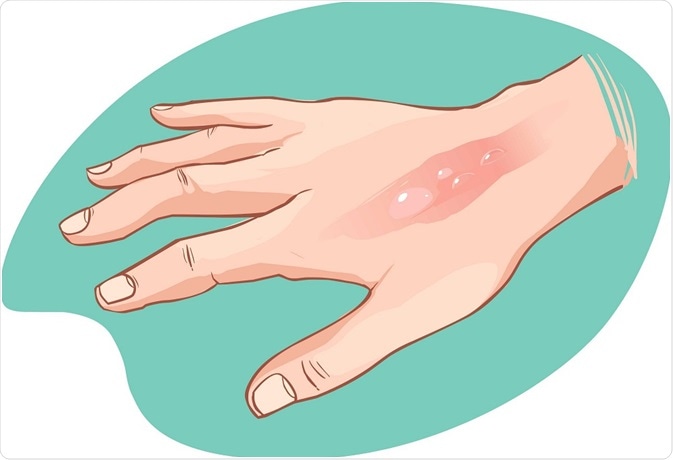It is important to respond fast when you, or somebody you know, is burned. This article describes how to treat a mild burn injury.

corbac40 | Shutterstock
A burn is defined as damage to body tissue caused by heat, chemicals, electricity, sunlight, or radiation. Burn injuries may also occur because of breathing hot air or smoke, which results in damage of the airways and lungs.
The signs and symptoms of a burn typically include reddened and painful skin, scars, blisters, and swelling. Deep burn injuries are often associated with infections due to damage to the protective skin layers.
Burns may be categorized into three groups:
- First-degree burns – minor burn injuries that affect the outer layer of the skin, called the epidermis
- Second-degree burns – this type of burn affects both the epidermis and the dermis, which is the skin layer beneath the epidermis
- Third-degree burns – this type of burn penetrates the full thickness of the skin layers and reaches deep into the subcutaneous fat layer. A deep third-degree burn may induce shock due to severe blood or body fluid loss, which may eventually lead to death.
Treating Burn Injuries
Treatment of a burn injury depends on the intensity of the burn, its location, and the area of the body surface that it covers.
A first-degree burn generally causes redness of the skin, painful sensation, and mild swelling. In some cases, small blisters may develop. First aid for a first-degree burn is as follows:
- Apply cold water, or a cold damp compress, to the burned area until the pain subsides
- Once the area is cooled, apply wound gel if available, otherwise cover with a light clean dressing or layer of clean fresh clothing to keep it free of dirt and protect it from further injury
- Remove any jewelry or other tight items from the burned area before it starts swelling
- If blisters appear, do not break them
- If pain persists, take over-the-counter pain killers.
- Once the burn is healed completely, protect the area from direct sunlight by wearing protective clothing or applying sunscreen lotions
Higher-degree burns are often associated with deep injuries. In case of burns in the hands, feet, face, groin, buttock, or major joints, immediate medical attention is needed. Steps that should be followed to treat a higher-degree burn case include:
- Immediately call for professional medical assistance
- Remove the source of burn rapidly and protect the burned person from further
- injury
- Make sure the airway, breathing and circulation are maintained first of all
- Cover the burned area with cool, wet, and clean bandages
- In case of a severe and large burn, do not immerse the affected area in cold water because it may cause significant body heat loss, a condition known as hypothermia
- Remove ornaments or other tight items from the burned area rapidly
In case of a higher-degree burn, medical treatment regimens may include:
- Wound healing medicines, lotions, and ointments
- Medications to relieve pain and anxiety
- Intravenous fluid administration to avoid fall in blood pressure and dehydration
- Regular wound dressings to remove dead or infected tissue
- Antibiotics to avoid infections
- Tetanus shots
- Physiotherapy – in case of burns that cover a major joint
- Breathing assistance – in case of burns that affect airway function
- Decompression surgery to remove constrictive burn scabs so as to restore normal blood circulation or breathing
- Skin grafting to remove scar tissue
- Plastic surgery to improve the appearance of scars
Further Reading
Last Updated: Nov 16, 2018